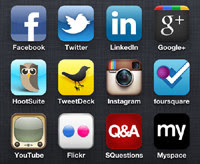So, this week is the beginning of spring, and if you’re here in DC, the
Cherry Blossom Festival is getting well under way – the warm weather we’ve had has them blooming earlier than usual.
 |
| Tulip. Photo: Leah Ibraheem. |
It’s also time to start your Spring Cleaning – clear out the clutter that’s been accumulating since last year, airing out the rooms, and get a fresh start.
Yes, your online properties could also use some decluttering.
Let’s start with your web site:
1) Is the contact information correct? Did you add or change any locations, phone numbers, or social media feeds since your last update? Don’t let missing or incorrect contact information stand in the way of a great customer experience.
2) Are the products current? Remove any items you’re not selling anymore. It’s also a good idea to suppress things you don’t have in stock right now, but might bring back later. You always want to point customers to things you have on sale now – things they can get right away.
3) Do you need to refresh your imagery? If you’ve had exactly the same images on your web site for several months now, you might want to refresh your hero photos and stories. A web site that doesn’t have rotating content can seem stagnant, like you aren’t really paying attention.
How about your Facebook page?
1) Have you updated with the new timeline structure? Do you have the images and other content you need to do this? Here’s a handy primer from
Social Media Examiner on the new look and feel, and how to make it work for you.
2) Are you using Facebook Insights? Facebook’s reporting can tell you the basic demographics of your fan base and how engaged they are. You can use this data to get more fans by advertising to people who are similar to your fan base. You can also use this data to talk about things that will interest your core demo in a way that appeals to them. It’s critical to know whether your Facebook fans are 20-year-old guys or 40-year-old women, and if they are in Topeka, Trenton, or Tuscon.
3) Are you using Facebook Ads? I find that Facebook ads can be more effective than Google ads at driving traffic – I have the option on Facebook to advertise to fans of other brands and of specific topics, so it’s can be easier to identify prospects on Facebook than on Google Adwords, where I have to decide what keywords my audience might be searching.
What about your Twitter feed?
1) Should you keep tweeting? I love
Twitter, but it can be a time-sponge. Now’s a great time to decide if you want to invest a little more time in Twitter by tweeting and retweeting every day.
2) Are you using twitter management tools? I use HootSuite to schedule and monitor tweets, but there are other tools that help you do the same. Scheduling tweets ahead of time can save you a lot of time, and keep you from ignoring Twitter for days at a time, which can be tempting.
3) Have you thought about a Twitter event? Hosting a Q&A with a product expert can be a highly effective way to get new followers. Try it and see what Twitter really can do.
How’s your spring cleaning going? Share in the comments and
let me know.



















